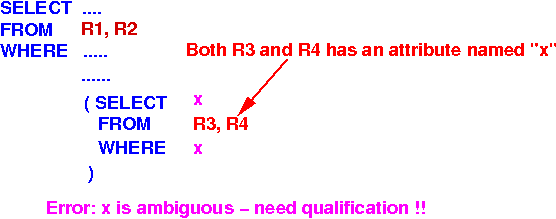Analogy:
scopes in programming languages
-
Scopes in
programming languages:
public static void main(String[] args)
{ // Outer scope
.....
{
.....
// Inner scope
}
}
|
-
Scoping rules
in programming languages:
public static void main(String[] args)
{
int i = 4;
{ // Inner scope
double x = 3.14;
System.out.println("i = " + i + ", x = " + x); // We can use i
}
System.out.println("i = " + i + ", x = " + x); // Error - can't use x
}
|
|
Scopes in
SQL programs
- Each
nested query
constitutes a
new inner scope:
SELECT ... // Outer scope
FROM ...
WHERE ......
(SELECT ...
FROM ... // Inner scope
WHERE ... )
|
- Scoping rule
in SQL:
- The names
of
relations
and
their attribute name
in an
outer query
are
visible (= usable)
in the
inner query
|
|
Example Scoping Rule
in SQL
- Example of
nested
query:
SELECT attr. names from R1 and/or R2 /* Outer query */
FROM R1, R2
WHERE attr.names from R1 and/or R2
....
/* inner query */
( SELECT attr. names from R1, R2, R3 and/or R4
FROM R3, R4
WHERE attr. names from R1, R2, R3 and/or R4
)
|
- The attributes
of R1
and R2
are
visible (= accessible)
in the
inner query
- But the
attributes
of R3 and
R4
are
not visible (= not accessible)
in the
outer query
|
Association rules for
attribute names
Association rules for
attribute names
SELECT .... /* Outer query */
FROM R1, R2
WHERE ....
....
( SELECT x /* inner query */
FROM R3, R4
WHERE x = ....
)
|
- If relation
R3
(or
R4) contains the
attribute name
x, then:
- the attribute name
x in the
inner query belongs to
relation
R3
(or
R4)
|

|
Association rules for
attribute names
SELECT .... /* Outer query */
FROM R1, R2
WHERE ....
....
( SELECT x /* inner query */
FROM R3, R4
WHERE x = ....
)
|
- If
both
relations
R3
and
R4 contain the
attribute name
x, then:
- the attribute name
x
is
ambiguous
and you must
qualify
it with
R3
or
R4
|

|
Association rules for
attribute names
SELECT .... /* Outer query */
FROM R1, R2
WHERE ....
....
( SELECT x /* inner query */
FROM R3, R4
WHERE x = ....
)
|
- If
relations
R3
and
R4
do not
contain the
attribute name
x, then:
- the attribute name
x in the
inner query
refers to
an attribute in
R1 or
R2
|

|
❮
❯


